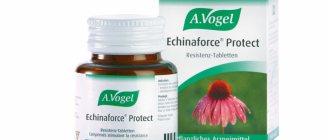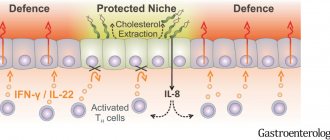What is interferon?
Interferons (IFNs) are a group of proteins that are released by cells in response to viral infection. In some cases, interferons begin to be released in response to infection by certain types of bacteria. Interferons were first discovered in 1957, when scientists Alik Isaacs and Jean Lindeman discovered that mice infected with one virus were not infected with other viruses. It was easy for scientists to conclude that in response to a viral infection, cells produce certain universal substances with antiviral activity2.
Currently, more than 20 interferons are known, which are divided into three types3,4:
- Type I – viral interferons. These include interferon alpha (IFN-α), interferon beta (IFN-β), and several other interferons. Interferons alpha and beta are produced in response to viruses, as well as bacterial components that stimulate not only the production of interferon, but also other immune mechanisms.
- Type II – immune interferon, including gamma interferon (IFN-γ). Unlike type 1 interferons, which are the first to respond to a viral infection, gamma interferon is produced at subsequent stages of infection.
- Type III – interferon lambda (IFN-λ). This type of interferon was recently discovered, and its mechanism of action resembles the first type of interferon.
VIFERON Suppositories in combination with Gel for frequently ill children
When VIFERON is included in a complex of treatment measures for frequently ill children [2], the following occurs:
- reduction in the duration of the fever period by 1.0±0.3 days versus 2.1±0.4 days in the control group;
- reduction in the duration of intoxication 2.7±0.3 days compared to 3.8±0.4 in the control group;
- reduction in the time of difficult nasal breathing 4.6±0.3 days compared to 5.4±0.4 in the control group;
- reduction in the duration of catarrhal syndrome by 3.3±0.2 days compared to 4.9±0.4 days in the control group.
Reference and information material
Author of the article
Shamsheva Daria Sergeevna General practitioner, cardiologist, Ph.D.
Sources:
- V. V. Malinovskaya, V. P. Timina, L. N. Mazankova, T. A. Chebotareva, Immunopathogenesis of acute respiratory infections, tactics of rational choice of etiotropic and immunomodulatory therapy in children // Children's infections, No. 4, 2013.
- Chebotareva T.A. et al. Children with recurrent respiratory tract infections: modified interferon therapy for acute respiratory infections // Attending physician, No. 6, 2012.
i https://www.sechenov.ru/
Loading...
Take other surveys
How do human interferons work?
Increased production of interferons begins when a cell is infected with a virus. Note that interferon does not act directly on the virus. First of all, interferon is a signaling molecule that affects neighboring cells, triggering processes in them that interfere with the replication of the virus. Under the influence of interferons, specific enzymes are synthesized in cells that interfere with the assembly of viral particles. Accordingly, the virus cannot further multiply, infecting our body. The second main property of interferons is to stimulate the immune system. In particular, some types of interferons present antigenic (foreign) agents to special T-helper cells of the immune system, which further down the chain pass it on to the next links of the immune pathway, ultimately destroying the pathogen5.
The antiviral properties of interferons have aroused great interest among researchers from the point of view of the treatment of a number of diseases. And over time, thanks to various medical and technological capabilities, it was possible to obtain medications that contain interferon.
Types of interferons (types). Their effect on the body.
Scientists distinguish three types of interferons: interferons of the first, second and third types. The first type of IFN includes IFN-α, which in turn are divided into several subtypes. Type I IFN also includes IFN-β, IFN-ε, IFN-κ and IFN-ω. One type II IFN is also known – IFN-γ. At the beginning of the 21st century, a new class of interferons was discovered - the third type, represented by IFN-λ, which includes IFN-λ1, IFN-λ2 and IFN-λ3.
The IFN system, which includes interferons alpha, beta and gamma, is able to respond as quickly as possible to signals from the body indicating the penetration of infection and damage to DNA and RNA of cells. Virologists identify four main links in the functioning of the system of these proteins.
The first link is induction. The human body has an ideally tuned signaling system that detects the penetration of infection from the outside within about half an hour. The response of the cellular genome is immediately formed and the second stage begins - production, i.e. production of IFN.
The product consists of the synthesis of interferons by cells of the immune system and their secretion into the environment. Within a few hours after infection, the concentration of functionally active IFNs in the peripheral blood reaches its maximum. Thus, the body becomes fully prepared to fight infection if the immune system functions without failures. As a rule, this only happens in an ideal world, where a person has no problems with the environmental situation, and he always eats right and has no chronic diseases. Otherwise, IFN drugs may be required.
The third link is action. IFNs begin to protect the body's cells from the foreign influence of viruses and bacteria. And then, effects are connected as the fourth link. There are more than three hundred of them in total, among them are antiviral, immunomodulatory, antitoxic effects, as well as activation of natural killer cells, synthesis of prostaglandins and many other activities aimed at the fastest possible recovery.
Use of interferon drugs in medicine
Interferon drugs are actively used in the treatment of a wide range of viral diseases. In particular, we are talking about the human papillomavirus, viral hepatitis, herpes infection, as well as influenza and colds. An important factor in the selection of drugs containing interferon for the treatment of a particular disease will be the concentration of interferon in the drug, how it is obtained and what type of interferon (α, β, γ or λ) it contains. Despite the fact that there are interferon preparations that are available without a prescription, it is still better to consult a doctor in advance, since there are a number of contraindications for these drugs. Based on the method of preparation, interferon preparations can be divided into 4 types6,7:
- Leukocyte interferon is obtained from donor blood.
- Lymphoblastic interferon is obtained from a culture of lymphoblastic cells.
- Recombinant interferon is obtained from bacterial or fungal cultures into which the human gene responsible for the production of interferon has previously been inserted. Most often, interferon preparations contain recombinant interferon.
- Pegylated interferons are produced by combining recombinant interferon with polyethylene glycol. This is done to ensure that the drug lasts longer in the body.
ARVI and influenza are common, but not the only causes of illness caused by viruses
Viral diseases rotate among the population all year round. Symptoms of a cold: runny nose, sore throat, headache, weakness are inherent in a viral disease. Most often, viruses that cause ARVI are transmitted by airborne droplets and household contact through dirty hands, surfaces, and objects. Naturally, the likelihood of becoming infected increases in crowded places, in transport, in pharmacies, especially if you have a habit of touching your face and mouth with dirty hands. Enterovirus infection is also common in children, which is especially dangerous for a small child, since the child’s fragile immune system cannot fully resist.
Advantages and disadvantages of introduced interferons
The advantages of drugs containing interferons include their availability. An important advantage of interferons is their possible use against a wide range of viruses.
The relatively high level of safety of interferon drugs allows them to be used by children, who, as is known, often suffer from influenza and other acute respiratory viral infections.
However, along with the advantages, such drugs also have their disadvantages. Often, excessive amounts of type 1 interferon are associated with suppression of innate antibacterial immunity mechanisms8 and can also provoke a decrease in the production of intrinsic interferon9.
Therapeutic effects of using VIFERON Ointment and Gel
Local antiviral immunomodulators include VIFERON Ointment and Gel. These products are applicable both for the treatment (ointment, gel) and for the prevention (gel) of ARVI. The article “Immunopathogenesis of acute respiratory infections, tactics of rational choice of etiotropic and immunomodulatory therapy in children” [1] summarizes the following results of the use of VIFERON Ointment:
- improvement in the general condition of the totality of symptoms occurred faster than in the control group (2.73 ± 0.35 days versus 4.29 ± 0.52 days);
- secondary infection was recorded less frequently compared to placebo (23.7% versus 45%);
- The transformation of rhinitis into purulent also occurred less frequently: 7.9% versus 20%.
Emergency immunoprotection against viruses
The effectiveness of natural interferons (produced in the body) has been proven more than once10. For this reason, given the disadvantages of drugs containing interferons, it is more advisable to stimulate the production of the body’s own interferon. Interferon inducers cope with this task. These are drugs that stimulate the production of one’s own (endogenous) interferon. Interferon inducers, unlike introduced interferons, are slightly allergenic, and most importantly, they cause prolonged production of endogenous IFN in physiological doses sufficient to achieve therapeutic and preventive effects11.
A natural activator of the immune system and, in particular, stimulation of its own interferon are bacterial lysates, which stimulate local immunity without affecting the functioning of the general immune system. One of these is the IRS®19 spray, which contains lysates of 18 bacteria that most often cause respiratory diseases. Unlike systemic immunomodulators, IRS®19 acts locally without interfering with the functioning of the general immune system. It is noteworthy that bacterial lysates are destroyed microorganisms that cannot cause disease, but do induce an immune response14. IRS®19 can be used by both adults and children from 3 months12, which indicates its safety profile. This is especially important because children’s immune systems, which have not yet strengthened, are less able to cope with respiratory infections, which is why children get sick more often13.
The advantage of IRS®19 is that in addition to activating the production of its own interferon, the drug naturally enhances other factors of local immune defense of the nasopharyngeal mucosa: phagocytosis, increases the level of lysozyme and the production of local antibodies, in particular, secretory immunoglobulin A, which makes it possible to cope with both viruses and viruses. and with bacteria. This complex effect on local immunity helps speed up the healing process by 2 times1. IRS®19 acts on the cause of the disease, prevents infection from entering the body and reduces the risk of complications by activating antiviral and antibacterial mechanisms of emergency immunoprotection at the entrance gates of infection13. When IRS®19 is sprayed, a fine aerosol is formed that covers the nasal mucosa, which leads to the rapid mobilization of protective mechanisms12,14.
Another important advantage of IRS®19 is the possibility of using the drug for preventive purposes. Immunological memory after a course of IRS®19 application lasts on average about 4 months13. Such prevention is especially relevant during the season of viral attacks for both adults and children.
Our body, in the process of evolution, has adapted to fight viruses, but if necessary, we can help it without interfering too much with its work.
Local antiviral to avoid getting sick
To prevent ARVI and influenza, it is advisable to resort to comprehensive protection. Both mechanical (mask) and antiviral means of protection will be an obstacle to the penetration of pathogens into the body. For example, Gel, which can be used to lubricate the inside of the nose. The antiviral drug VIFERON Gel is a local immunomodulator for the prevention of ARVI, which is easily absorbed into the nasal mucosa, enhancing local mucosal immunity. The gel has a light texture, does not spread, and has a neutral smell and taste. The features of this product include a convenient frequency of administration: it is enough to take it 2 times a day (morning and evening).




